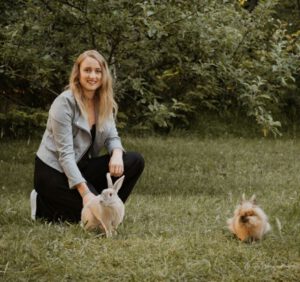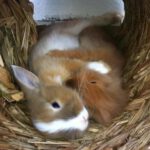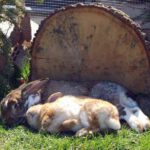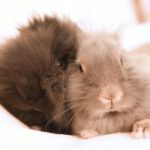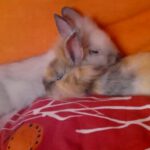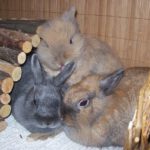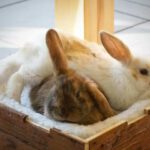Contents
Megacolon
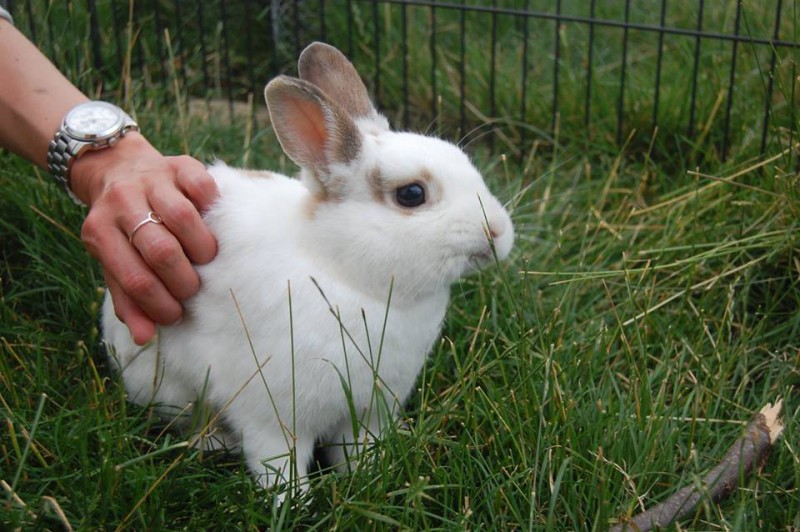
Megacolon syndrome is often hereditary; affected rabbits are also referred to as Chaplins or Weißlinge (literally “whities”). However, Weißlinge are not necessarily white, as the name might suggest—they are usually patterned. Because this term is often confused by laypeople with albino rabbits, it is rarely used nowadays. The term Chaplin is derived from Charlie Chaplin, whose black-and-white appearance in old silent films resembles the markings of affected rabbits.
Megacolon (an enlarged colon) can also result from chronic constipation or hairballs. This can affect rabbits of all color types.
What symptoms do affected rabbits show?
Chaplins typically exhibit some of the following symptoms:
- As babies: Delayed development—these young rabbits are significantly smaller than their siblings (minor size differences are normal, but with Chaplins the differences are extreme). Many breeders cull Chaplins a few days after birth.
- Unstable digestion, often alternating between constipation and mushy stool, or recurring mushy droppings, or chronic constipation or diarrhea.
- Ongoing, recurring digestive issues such as bloating, constipation, mushy stool, or diarrhea—without any identifiable cause (diet, parasites, and dental issues have been ruled out), or sometimes with recurring parasite infestations.
- Persistent infestations with parasites such as coccidia, yeasts, and worms—barely have they been treated before the parasites return, or are replaced by others.
- Bloated, round belly despite an otherwise lanky or thin body structure.
- Weight loss or difficulty gaining weight—affected rabbits often eat large amounts of food but do not gain or even lose weight.
- Megacolon (an enlarged colon that disrupts digestion and impairs nutrient absorption)—usually caused by a genetic predisposition, but sometimes also triggered by constipation. It is difficult to diagnose unless the rabbit undergoes an exploratory surgery (diagnostic laparotomy) or a veterinarian detects it via ultrasound (rare) or X-ray (also rare).
- The animals often have a generally weak immune system and are prone to frequent illnesses.
- Early death—most rabbits with the condition do not live beyond two years. In milder cases, some may live to be four, five, or even six years old.
Development (initially normal, later severe decline, death at one year of age):
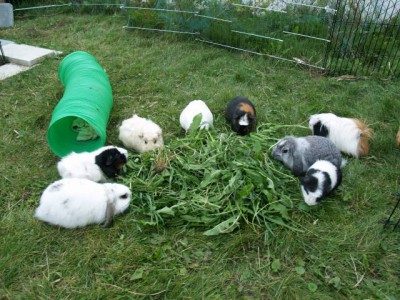
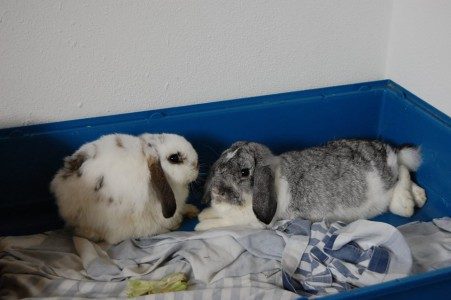
Blume was purchased from a hardware store where little importance is placed on professional breeding. The animals usually come from mass breeding operations, and their parentage is unknown. Her development started out normally (apart from a pre-existing coccidia infection and slightly slow growth). Around the age of one, she began to suffer from chronic diarrhea, persistent infestations with coccidia and yeast (constantly changing), and she lost a significant amount of weight despite having a strong appetite and receiving supplemental feeding. She visibly „shrunk“—especially when compared to her partner Klopfer, who was originally the same size.
When her condition continued to deteriorate, we decided to perform an exploratory surgery. Her cecum and colon were extremely enlarged. She was humanely euthanized.
Genetics: How is megacolon inherited?

Chaplins are a problem within the breeding of spotted (broken pattern) rabbits, which can be explained genetically and also prevented.
Spotted rabbits can carry the spotting gene K in two different ways:
- If they are homozygous (KK), they carry two copies of the spotting gene. These rabbits are known as Chaplins and are typically affected by megacolon.
- If they are heterozygous (Kk), they carry only one copy of the gene and usually show a normal broken pattern without developing megacolon.
The classic spotted rabbit (broken pattern) is not homozygous (KK), but heterozygous (Kk).
This means that a rabbit carrying the spotting gene (K) is bred with a rabbit that does not carry the gene (k)—for example, a solid-colored rabbit. As a result, the offspring carry the spotting gene and show a broken pattern, but do not develop megacolon.
However, some breeders or mass producers are unaware of this and breed two spotted rabbits together (both carrying the spotting gene) to produce more broken-patterned offspring. Since the spotting gene not only causes the distinctive coat pattern but is also linked to the semi-lethal factor and megacolon syndrome, it should never be passed on in a homozygous form (KK).
Megacolon syndrome is representative of this genetic issue, but it is actually just one symptom of a broader underlying condition. (This is similar to how E. cuniculi is often referred to as the „stargazer disease“ due to the tilted head symptom, although many affected rabbits show different or no neurological symptoms at all.)
The actual symptom complex associated with homozygous spotting goes beyond megacolon, as described above.
In rare cases, rabbits can develop megacolon without being a broken-pattern rabbit or related to one.
Further information on this can be found in the next section.
Which rabbits can be affected?
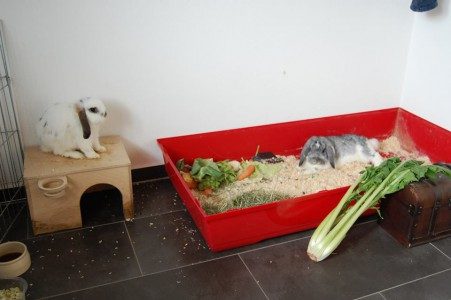
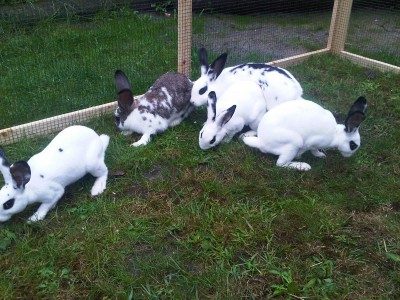
Chaplin rabbits:
To determine whether a rabbit might be a Chaplin, it is helpful to know the parent animals. Information on the inheritance of Chaplins can be found [here].
However, due to heavy crossbreeding in the spotted rabbit lines, many mantle-marked rabbits (especially from European breeding lines) may also carry the gene associated with megacolon. As a result, even mantle-marked rabbits bred with each other or with a broken-pattern rabbit (English spot) can produce Chaplins.
Not affected by the spotting gene are typically:
- Dutch rabbits (even though they appear „spotted“),
- American mantle-marked rabbits, and
- solid-colored rabbits (those with no white on the body).
These can be safely bred with broken-pattern rabbits without producing offspring affected by megacolon.
Most Chaplins have a very high percentage of white and little actual patterning (less than 5%), though some may show more extensive spotting or appear nearly all white. Based on breeders‘ experience, rabbits that have color or pattern on their belly (rather than a completely white underside) are rarely affected. The likelihood of a rabbit being a Chaplin increases when:
- the white coverage is extensive,
- the dorsal stripe (along the back) is broken or missing,
- the belly is entirely white, and
- the butterfly marking on the nose is absent or incomplete.
Other cases of megacolon:
Rabbits unrelated to broken-pattern lines can also develop acquired megacolon. In these cases, chronic constipation may have caused food matter to back up and stretch the colon, eventually leading to megacolon. This form is not genetic and can potentially affect rabbits of any breed or color.
Diagnosis
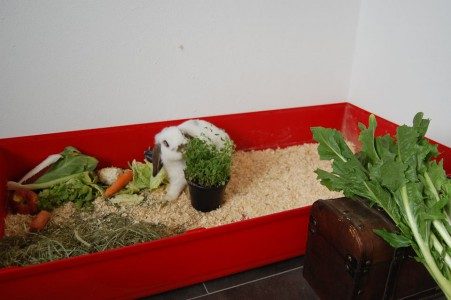
The coat color of the parent animals, the appearance of the affected rabbit, and the symptoms can provide the first indications of a possible Chaplin case.
In cases of megacolon, microscopic examination of the hard feces often reveals large amounts of cecal bacteria and embedded fibers. Diagnosis can sometimes be supported by ultrasound or X-rays, though the condition is not always clearly visible through imaging.
Additionally, a genetic test is offered by LABOKLIN (via EDTA blood sample or cheek swab). However, this test currently only confirms certain genetic forms of the condition with reliable accuracy.
Treatment
Treatment for megacolon is only symptomatic. Despite treatment, affected rabbits usually pass away early (depending on the severity of the condition), but their suffering and pain can be alleviated, and their life may be prolonged. With mild megacolon and optimal nutrition, they may also live to an older age.
Depending on the symptoms, any associated conditions (e.g., yeast, coccidia, bloating, diarrhea) should be treated symptomatically.
Diet:
Chaplins should be fed primarily fresh greens, such as herbs, wild plants, twigs with leaves, vegetable tops, dandelion leaves, endive, cabbage, and hay (no seeds, no dry food). Fruits and root vegetables should only be given sparingly if well tolerated.
Rabbits with megacolon often require Himalayan salt licks, as their digestive issues cause a deficiency in minerals. It is recommended to offer these salt licks at all times. Alternatively, saline solution can be provided in addition to water (never replace the water).
In some cases, affected rabbits may need infusions to correct electrolyte deficiencies (based on blood tests).
Medication and Diet:
A digestive diet and the medications listed in that diet can be used for treatment. These medications may need to be administered long-term.
If the rabbit continues to show symptoms despite all measures, it is helpful to keep a diet diary. With a digestive diet, foods are introduced gradually, and the diary helps identify poorly tolerated foods.
The goal is to stabilize the gut flora and regulate digestion, which is disrupted by the enlarged colon and its impaired function.
This treatment usually results in stabilization and a better overall condition, or at least a significant reduction in symptoms.
Important:
- No other digestive medications (such as malt paste, BeneBac, Nystatin, etc.) should be used.
- In addition to the fresh greens diet, supportive digestive aids should be administered. These can be given either as a short-term treatment or continuously, as needed (e.g., Rodicare Dia for gut flora regulation).
Parasite monitoring is crucial—fecal samples should be tested for parasites 3-4 times per year since affected rabbits are highly susceptible to parasitic infections.
For Rabbits with Constipation, Slow Digestion, and Hairball Tendency:
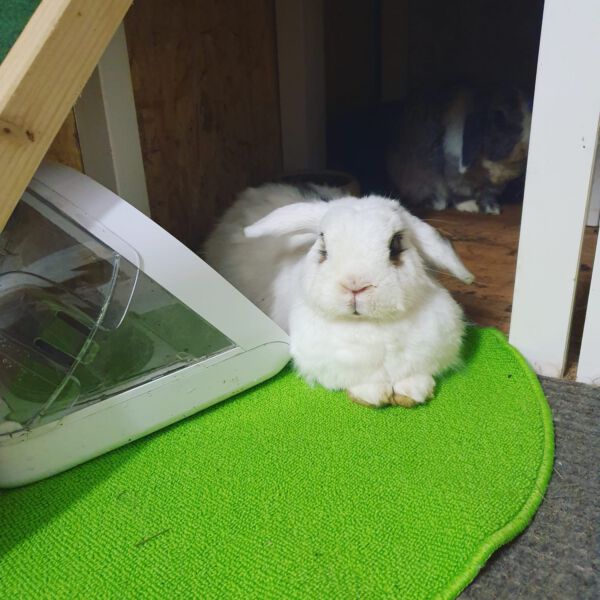
- Flaxseed oil or other cooking oils can be hidden in grated apple and fed to the rabbit.
- Flaxseed cake/pellets or caraway seed cake/pellets can be used as a supplement, offering 1-2 pellets daily.
- Cabbage family greens (such as savoy cabbage, kale, kohlrabi leaves) or clover should be introduced slowly and offered regularly.
- Water-rich fresh foods (e.g., cucumber, lettuce) should be fed in small amounts as part of the green feed.
- In addition to the water bowl, offer a separate bowl with carrot juice or fruit juice to encourage the rabbit to drink more.
- Consider a course of RodiCare Acute for 10 days if digestive issues persist.
- Offer caraway seeds, anise, and fennel seeds to aid digestion.
- Food cellulose can be sprinkled daily over the moist fresh food or added to Cuni Complete.
- Some rabbits benefit from a consistent addition of Cuni Complete (1 tablespoon per day, soaked in a little water before feeding).
For Rabbits with Tendency to Bloating and Stomach Overload:
- Administer RodiCare Acute daily for at least 30 days.
- Offer caraway seeds, dill seeds, fennel seeds, and anise seeds to support digestion.
- Kitchen herbs: Dill, peppermint, lemon balm, basil, parsley, thyme, oregano, sage, chives, wormwood, lovage, lavender, nettles.
- Wild and meadow herbs: Angelica, dandelion, oak bark and oak leaves, wild garlic, chamomile, willow catkins and twigs, yarrow, chicory.
For Underweight Rabbits:
- Severely underweight rabbits can occasionally be given 1 tablespoon of soaked Cuni Complete (or similar) per day, which can sometimes help them gain weight.
- Oats, dry food, and seeds often lead to yeast overgrowth and are poorly tolerated, so these should be avoided.


